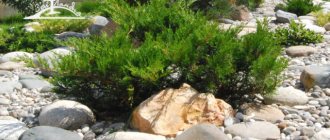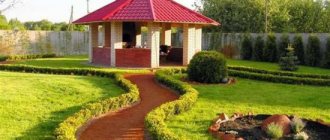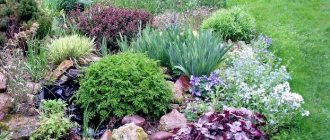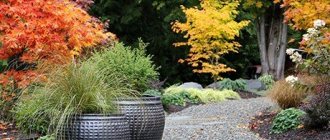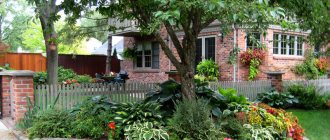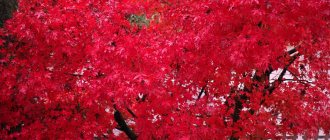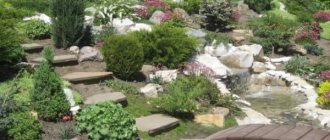When creating their own garden on a summer cottage or next to a country cottage, any owner strives to make it beautiful. True, some prefer to devote a large area to a vegetable garden with vegetable beds, others to fruit and berry plantings, and still others to a recreation area. But, as a rule, no one can do without flowers.
Flowering plants are for a landscape designer what paints are for an artist.
Features of flower arrangements in the garden at the dacha
Flower arrangements in the garden and at the dacha can be different. If the garden is large, then in addition to flowers there will probably be plantings of trees and shrubs, a lawn, often a swimming pool, gazebos, and paths. And in this case, it is important that the flower arrangements are in harmony with all other elements of the landscape in the garden.
Even a beginner can create a flower garden on his own site, but it is important that the plants really decorate the garden, and do not make it overly colorful and tasteless
It’s good if a landscape designer takes part in the project. But even if the owners do the design themselves, they can beautifully and competently fit all the garden compositions into their summer cottage. If, instead of a large garden, there is just a small dacha, mainly with vegetable beds, then here too it is quite possible to make beautiful islands by placing flowers in the garden near the house. Any flower compositions in the garden and country house are designed to be beautiful and pleasing to the eye. Therefore, it is important to choose the right plants, according to flowering time, shades, height, so that they form harmonious combinations.
You can make any area lighter and more spacious with the help of herbaceous plants blooming with white or yellow inflorescences.
A decorative border of flowers can decorate any garden path
What is a rock garden?
This type of pleasure is a miniature slide made of stones. I do it artificially, observing smooth lines. To create these plantings, low-growing crops are chosen.
In fact, the rock garden is one of the varieties of original flower beds. In this case, the plants are located among small stone blocks. It is not recommended to plant a large number of decorative flowers in rock gardens. An average of 6 types of decorations are chosen to create.
What to choose to create small architectural forms? To do this, it is recommended to plant:
- Cossack juniper;
- Phlox subulate;
- Hosta;
- Marigold;
- Petunias.
The distance between plantings should be on average up to 30cm. If you plant them too close to each other, then during the process of active growth they can spoil the whole idea. As a result, the flowerbed will appear unkempt.
The most popular types of flowers for garden decoration
There are a variety of flowers placed in the garden plot. Popular perennials include delphiniums, lilies, roses (some varieties of these flowers can be grown both at home and in the garden), phlox, tulips, lilies of the valley, peonies, gypsophila, astilbe, and hydrangea.
Spring tulips are deservedly popular among gardeners.
Of the annuals, the most common are marigolds, cosmos, poppies, calendula, petunias, morning glory, and nasturtium. They do not require special care and even an inexperienced gardener can cope with planting.
It's hard to imagine a summer cottage without delicate peonies
Popular climbing plants include sweet peas, wisteria, and clematis. Irises, loosestrife, and marigold are planted near ponds and streams. In the shady garden there are ferns and hostas. Juveniles, alyssum, carnations, tulips, and haretail are suitable for alpine hills.
Luxurious lashes of climbing roses will decorate the fence, which, in turn, will serve as a support for the plant
Before planting certain flowers nearby, you need to carefully consider how they will combine with each other in color, height, and how they will harmonize with other elements of the landscape. To do this, you need to look at the detailed description of the species.
Clematis will be a chic decoration for a pergola or the wall of a country house
Plant selection
To decorate the site, it is necessary to use coniferous plants that fit most harmoniously into any landscape. It is coniferous specimens that are able to emphasize the beauty of perennial flowers and shrubs that are planted next to them.
A mixborder is a limited space in which conifers and perennial flowering plants grow. Such flower beds attract gardeners with their continuous flowering throughout the year.
What to consider when selecting coniferous plants
Coniferous flower beds with perennials are the best option for decorating a site, since these plants require minimal care. At the same time, they retain their beauty and attractiveness at any time of the year.
When choosing conifers for compositions, you should take into account the width of their growth and the difficulty of care. In one mixborder it is necessary to select specimens that can withstand the same conditions and prefer soil with the same characteristics.
It is important that the plants adjacent to them can also grow in the same conditions, on the same soils.
Division of coniferous plants into families:
- Pine - fir, spruce, cedar.
- Cypress - thuja, juniper, cypress.
- Yew - yew, torrey.
Here is one of the successful composition options with coniferous plants:
- dwarf spruce;
- creeping juniper;
- low-growing representatives: thuja, fir, pine.
Tall species of conifers
The composition of coniferous plants must contain at least one tall specimen. Planted in the center of the flowerbed, it will set the tone for the entire plant ensemble. Around a tall tree you can plant shrubs and groups of perennial flowers.
When creating an emerald lawn, for example, you can choose Hoopsie spruce for the central part of the composition.
Spruce with blue needles will decorate any composition. It grows up to 10 meters in height, spreading its crown 4 meters wide. Not afraid of frost, not picky about the soil.
Thuja Brabant, growing up to 3.5 meters, can “lead” the mixborder along the fence. The tree is evergreen with a narrow pyramid-shaped crown.
The lower branches grow at ground level, covering all unsightly buildings. With Brabant, hedges are often formed and beautiful alleys are created.
Korean fir in nature can grow up to 12 meters. Grows well in the shade, but prefers fertile soil and timely watering. As soon as the tree reaches a meter in height, violet-purple cones appear on it.
Serbian spruce is an unpretentious tree; in nature it grows up to 45 meters. Attracts attention with the beauty of the needles and the color of the cones. There is a large selection of varieties to create a composition. The tree is not afraid of frost and can grow in the shade.
The Skyrocket juniper or pencil tree attracts the attention of gardeners with its unusual proportions. The branches form a narrow columnar crown, which is suitable for creating a composition of coniferous trees. Grows up to 7-8 meters.
Thuja Smaragd grows in the form of a cone up to 5 meters in height, and the crown is only 150 cm wide. It loves sunny areas and regular watering. Can live 100 years.
The tallest thuja is the thuja foldata. A giant tree in nature can grow up to 60 meters. The volumes in diameter are also impressive - 2.5-3 meters. It got its name for its thick, dense crown, where bright green needles overlap each other like scales.
At home, her height is 13-14 meters. Thuja foldata is a real long-liver. Live in one place for 800 years! Adapts to all conditions and grows well.
Medium-sized plants for coniferous compositions
A mixborder of conifers, which are called medium-sized, will look very original if dwarf trees and flowers grow in the neighborhood.
Konika spruce is good because it does not require cutting. Growing up to 2 meters, it has a perfect cone. Thick soft needles of soft green color stand out beautifully against the background of other trees.
Prefers sunny places. Grows well on slightly acidic and neutral soils.
The dacha will quickly acquire a well-groomed appearance if you plant the fast-growing Green Carpet juniper in the flowerbed. In 9-10 years it will grow to 200 mm, spreading its branches 150 mm. The branches are so intertwined with each other that a fluffy “cap” is obtained. Can grow in partial shade on calcareous and sandy soils.
Compacta Glauka pine with a dense pyramidal crown is suitable for stone mixborders and alpine slides. It grows by 80-150 mm annually. Pine grows well in moderately acidic soils.
Thuja Aurea Nana orientalis reaches a height of 170 cm. It attracts attention by changing its color. During the warm season it becomes golden-green, and in winter it acquires a bronze tint.
Barry spruce has a spherical shape. By the age of 25, the tree grows to only 200 cm. It grows well on sandy and loamy soils. Will decorate any coniferous mixborder.
Canadian yew, up to 2.5 m high, has a pyramidal shape. You can give it any shape with a haircut. Unpretentious, but the needles are toxic. When cutting hair, you must wear gloves.
Low-growing and creeping conifers
Any coniferous corner will be decorated with creeping and low-growing conifers.
Thuja Caespitosa grows only up to 40 cm. It is famous for the fact that over time it acquires an unusual semicircular shape in the form of a “pad” of thick light green needles.
With mountain pine, Mini Pug can carry out various experiments, creating different shapes by cutting it. Loves illuminated places, looks good on alpine slides.
Thuja Amber Glow is a spherical shrub valued for its golden color. If grown in the shade, the color will change to green.
The creeping juniper Plumosa will perfectly decorate a coniferous corner. Shoots from the trunk grow 2.5 meters, filling everything around. Can grow in any meta and is completely unpretentious. In the shade, green leaves turn into light green.
The cross-paired microbiota is represented by cypress, the new shoots of which are covered with needles in the form of needles. As the needles grow, they turn into scales. In summer the bush is dark green, and in winter it is copper-brown. Microbiota can develop even in the shade and on rocky soils.
The decorative creeping juniper Golden Carpet is endowed with an unusual color. The upper part is covered with golden needles, and the lower part is covered with yellow-green ones. To see the unusual effect, it must be planted in a sunny area.
The weeping Lorelei spruce begins to creep along the ground after grafting. The shoots first rise beautifully to 60 cm, then fall and spread across the flowerbed, creating a beautiful fluffy carpet.
Creeping Canadian hemlock will help you create a beautiful mixborder. By the age of 10 it grows to 500 mm. Does not withstand drought, prefers partial shade and moist, slightly acidic soil.
Thuja Hoseri has the shape of a ball, which is why it stands out in landscape design. In summer, the thuja is covered with green needles, and in the fall they change to a bronze-brown tone. Young trees need shelter before the winter cold.
Tips and tricks for using flower beds
In order for a flower bed to please the eye for a long time, you need, firstly, to take into account the flowering periods of different types of plants. Sometimes they are planted in such a way that when some fade, others immediately bloom, so that “emptiness” is not created. Sometimes long-flowering plants are selected, with the same flowering period, combined in color. Together they create the desired accent in the landscape.
Unpretentious wildflowers will add special summer romance to your yard
It is also necessary to take into account the ecological characteristics of the species: you should not plant moisture-loving and drought-resistant species in the same flowerbed; shade-tolerant and light-loving. In addition, it is worth remembering that the most beautiful and vibrant flower beds will look best against the background of a plain lawn with lush greenery, or next to dark green conifers, or framed by herbaceous green plants. Also, any flower bed, even with the most unassuming plant species, requires at least minimal care - periodic weeding, fertilizing, removing dead stems, flowers and leaves.
A simple flower bed with bright flowers around the edges will adequately decorate a lawn in a suburban area
Creating beautiful flower arrangements in your dacha garden is not that difficult. There can be a lot of design options depending on the preferences of the owners, area of the site, budget, environmental and geographical features of the area.
The principle of constructing a landscape composition from coniferous plants
In order for coniferous compositions to fit into the overall appearance of the garden, you need to choose the right place, then draw the location of the trees and shrubs on paper.
The principle of building a mixborder
- After selecting a site, the next principle of composition comes - gradation. If the coniferous flower bed is located near a fence or wall, tall trees go into the background.
- In the center, slender, elongated seedlings are also being planted.
- The second layer of the composition is planting low-growing shrubs. These can be decorative varieties of mountain pine or thuja.
- The last row is creeping junipers or other conifers.
- The elements must be combined in shape and height. The tall element of the flowerbed should be followed by the middle one, then the low one. Behind the small one are creeping specimens.
- Next comes the choice of colors. Conifers provide a wide palette of green colors and a variety of mixed shades - yellowish, purple, golden, brown. You should not strive for diversity; it is better to choose 3-4 colors. These can be contrasting combinations or in the same color palette.
- Functional purpose of the flower bed. If the goal is aesthetic decoration, then the best choice would be a rock garden or alpine slide. More practical options are mixborders or hedges.
- Symmetry and asymmetry are an important part of creating a green corner.
Geometry of shapes
Coniferous compositions can be of the most incredible shapes: elongated, round, rectangular, triangle-shaped, free-form continuous flowering. A flowerbed of conifers and perennials in the form of a long stream with soft bends looks impressive.
If the flower beds of coniferous plants are large, then a narrow path should be made among the plantings to make caring for the composition easier.
A classic solution is a mixborder of conifers and shrubs. This mix is most often made as a hedge or to cover unsightly outbuildings and fences. In this case, conifers are planted in the background, and shrubs are planted in front of them.
If the composition is in the middle of the garden plot, then plant conifers in the center. When choosing shrubs, you should pay attention to species such as lilac, elderberry, magnolia, hibiscus, and hosta. The main thing is that the shrubs are not taller than coniferous specimens.
Photos of beautiful flower beds in suburban areas
Modular flower bed designs
To construct such structures, you will need a large free area. Markings are made on it for sections in which certain types of ornamental vegetation will be planted. Free areas between modular flower beds can be filled with fine gravel, wood chips or sown with lawn grass.
Flowerbeds can reach a height of up to 1.5 m. Wooden structures and a metal frame are used for their arrangement. For stability, the bottom of the container is covered with a large amount of drainage from small pebbles.
Based on the geometric shape of the crown, trees are divided into:
Natural, spreading, weeping, umbrella-shaped, spherical, columnar, cone-shaped, squat, creeping, domed, pyramidal. Within each form, some variations are possible that do not, however, go beyond the general characteristic characteristic of this form.
- Weeping - weeping columnar, weeping spreading, weeping dome, weeping cascade, weeping flag-shaped.
- Globular - oval, lower oval, upper oval, fan.
- Columnar - columnar-conical, columnar-dome, wide-conical.
Distinctive features of the tapeworm
In this case, single plantings of an ornamental plant of the same species are used. When choosing green spaces, it is necessary to take into account the ability of the decorations to regularly maintain the condition of the plantings.
Tapeworm is planted on a perfectly flat lawn. What can you choose for single plantings? White dogwood, thunberg barberry, Japanese quince, viburnum buldenezh, and tea roses are suitable for this.
When choosing decorative plantings, it is necessary to take into account their height and the need to care for their crown. For example, the annual growth of Japanese quince is on average 10-15 cm per year. This speed negatively affects the condition of the decorative crown.
Linear perspective
The visual change of objects as they move away from the observer is called linear perspective. You have probably repeatedly noticed how the parallel lines of a long straight highway converge on the horizon, while the vertical lines (of poles or trees along the highway) remain vertical, only decreasing in size. You may also notice that short plants in the foreground (close to the observer) appear taller than taller trees located in the distance. Therefore, you can deliberately “increase the depth of space” of your garden by planting larger plants in the foreground than in the background, thereby creating an artificial perspective. In addition, eastern park designers, to create the illusion of depth of space, narrowed the paths leading from the entrance to the building or brought the walls enclosing them closer together. For the same purpose, you can reduce the size of the paving slabs and change the texture of their surface: from rough, “rough” to smooth, “blurring” the contours of the path.


